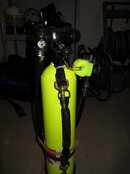Jorgy
Contributor
I have a 19 CF pony......
First a button gauge, too small and hard to read........
Small OMS gauge on 6" HP hose - worked well but made a "big" clump of stuff at the top of the tank, I sling my pony on my left side and I run my back gas gauge under my arm and clip it on my D-ring, so with my pony gauge it meant two gauges right next to each other........
So I settled on a 1" gauge - see picture below, large enough to read but small enough to not be in the way.........
I top off my pony every time I fill my tanks......I take a few breaths of the tank on each dive to check it works and practice deploying it.......so I loose a bit every dive......
My LDS tops them off for free, so it is no big deal........
Hope this helps...........M
First a button gauge, too small and hard to read........
Small OMS gauge on 6" HP hose - worked well but made a "big" clump of stuff at the top of the tank, I sling my pony on my left side and I run my back gas gauge under my arm and clip it on my D-ring, so with my pony gauge it meant two gauges right next to each other........
So I settled on a 1" gauge - see picture below, large enough to read but small enough to not be in the way.........
I top off my pony every time I fill my tanks......I take a few breaths of the tank on each dive to check it works and practice deploying it.......so I loose a bit every dive......
My LDS tops them off for free, so it is no big deal........
Hope this helps...........M





